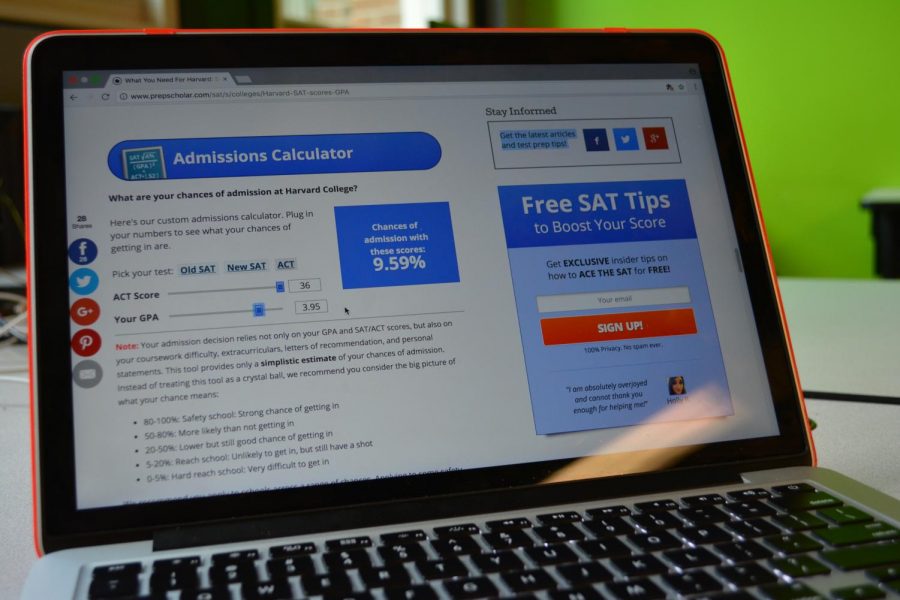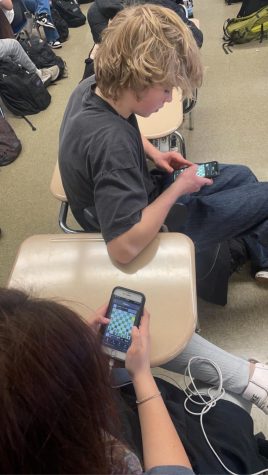The reality behind the acceptance calculators
Using PrepScholar, a student only has to type in their standardized test score and GPA to receive the calculation.
June 14, 2018
A senior happily presses submit and nervously waits months to see if they have been accepted into the colleges they’ve applied to. While they may have a certain idea on if they will be accepted or not, the final verdict is not in their hands anymore. After waiting months and months, this senior looks to their best friend for help: the Internet.
When applying to colleges, students are able to receive multiple estimates of their chances of getting in by using the different acceptance calculator websites.
By entering standardized test scores (SAT/ACT) as well as GPA, many websites will present a scattergram of how a student ranks in comparison to others, and often gives a percentage of how likely the student is to get into a specific school. Some of these websites include Naviance, Niche, Cappex, Princeton Review, PrepScholar and College Greenlight. However, these websites do not always tell the full story.
Ralph Balita, Div. 870, who will attend the University of Illinois at Urbana-Champaign this fall, was once a frequent user of these websites. Although he found Naviance “extremely accurate” and also found Niche beneficial, he does think there are some gray areas.
“One thing that I feel that needs to be taken into consideration is what college, or what school within the college is they are attempting to get into,” Balita said.
Ms. Hart, head of the College Fair and Administrative Head of Counseling, expanded upon the weaknesses of the scattergrams. Hart explained that colleges “don’t just want a number.” Rather, “they want to know if they are a volunteer, if they participate in a club, are they in a sport, what else are they doing in society as a person,” Hart said.
Ms. Bantz, head counselor, also weighed in regarding the acceptance calculator debate.
“Aside from Naviance, College Greenlight provides a fairly reliable scattergram,” Bantz said. “I do believe the College Greenlight scattergrams are self-reported though, so there is likely some inaccuracy in reporting.”
This is the same for other websites such as Niche and Cappex, where students have to manually create an account, so in self-reporting their scores or GPA, they may be estimating.
While some find these websites very helpful and a catalyst to start the college process, others, like Ari Greenberg, felt they were not totally accurate.
“None of them were super accurate because it depends on what you’re looking for,” Greenberg, Div. 877, said. “If you’re applying to a school that is really really really selective, none of those are going to give you an accurate representation of what the actual stories are.”
This is seen commonly, as many students find themselves scared to apply to a top school because of there online percentage.
Hart said that these calculators should only serve as a “gage to tell a kid what there chances might be, but it shouldn’t tell a kid not to apply.
Rather than using the acceptance calculators, Greenberg found it beneficial to ask friends instead.
“Just working on applications with my friends made it a lot easier than learning stuff online, because none of it is personalized and it is a random algorithm,” he said.
Greenberg also advised not to pay for any acceptance calculator, because they all use the same algorithm. Websites that charge include Princeton Review, which only lets users use the calculator three times, and a 30 minute phone consultation before pay.
Although these websites can be helpful to some, it seems most people have come to the conclusion that the acceptance calculators are not 100 percent accurate, and they shouldn’t have a heavy effect on a student’s application process.
“You never know who is going to read that application and say, ‘I am going to take a chance on that kid,’” Hart said.







